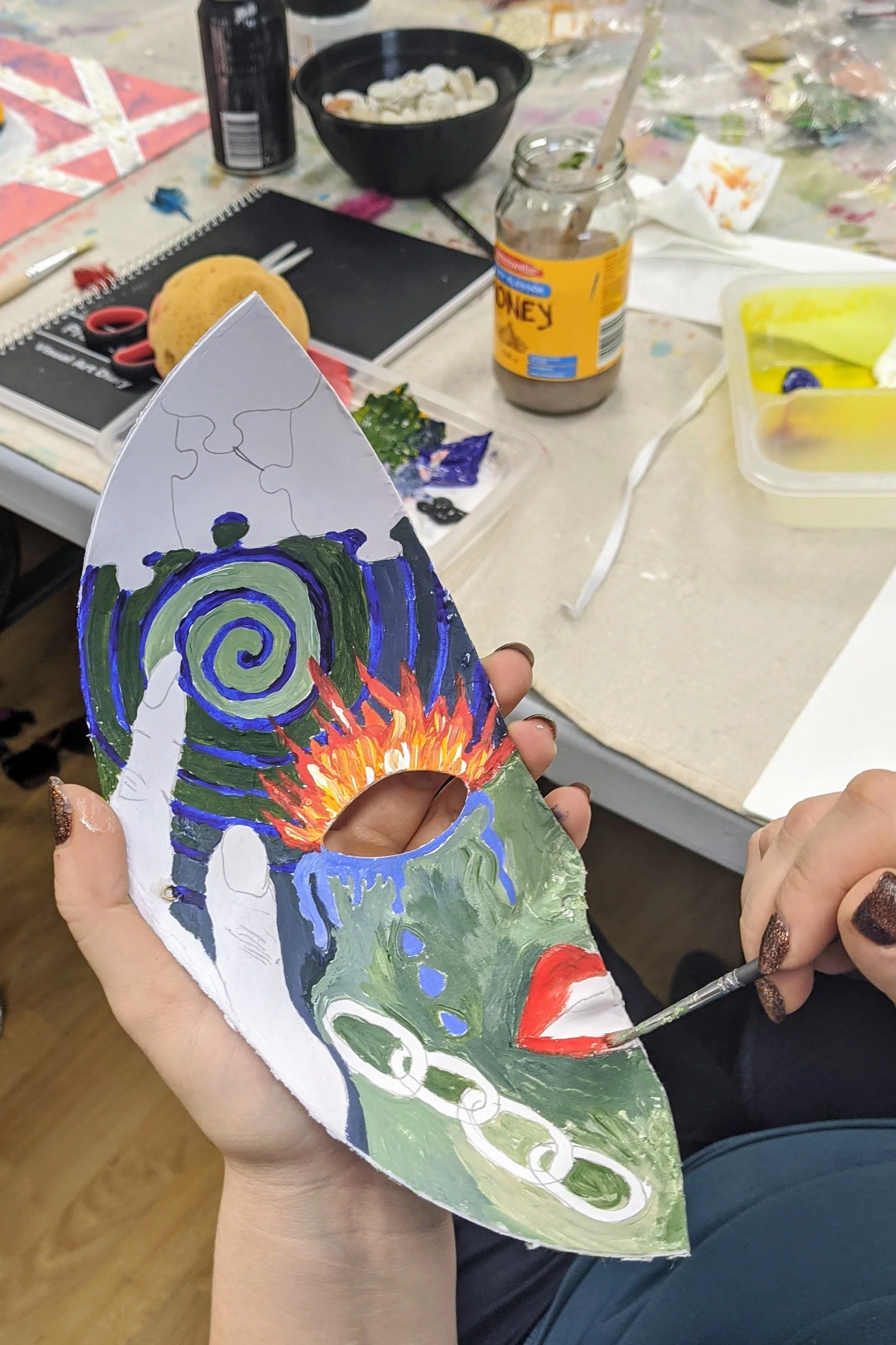Art in Schema Therapy.
8th June 2025
Exploring the self from the inside out, painting the inner world reveals what words sometimes cannot. A fusion of art therapy and schema work in practice.
Over the past couple of years, I’ve been studying schema therapy and found myself increasingly drawn to the possibilities of integrating it with art therapy. The blend of structured cognitive work with creative, image-based processes seemed super compatible! These are some reflections which have grown out of my reading and study notes!
Schema therapy is known for its integrative nature. It draws from cognitive, behavioural, psychodynamic, and experiential approaches to help clients address long-standing patterns that were often formed early in life. These patterns, or schemas, are more than thoughts. They are emotional truths shaped by experience. Over time, they influence how people relate to themselves, others, and the world.
What makes schema therapy distinct is its attention to these emotional undercurrents and its use of experiential techniques to access them. Guided imagery, chair dialogues, and rescripting are common tools, all designed to shift the client’s felt sense of self and safety. These methods allow people to revisit difficult memories, understand behavioural patterns or internal conflicts in a way that can bring healing.
Yet I think there is another experiential tool that deserves more attention in this context: art. Visual expression through drawing, painting, sculpture, or collage has long been used in art therapy to externalise emotion and create a bridge between the inner and outer world. This makes it uniquely suited to complement schema therapy, which often targets experiences that lie beneath conscious awareness or beyond language. Just as art creates a visible link between what is felt inside and what is seen outside, schema therapy works to build an affective bridge connecting early emotional memories with present-day awareness so they can be understood and transformed.
Using art based techniques clients might represent what they struggle to name or verbalise, allowing complex emotional material to surface in a more manageable form. This is especially relevant in schema therapy, where modes like the Vulnerable Child or the Punitive Parent may feel abstract until they are fully embodied and given form.
In practice, integrating art into schema therapy can take many forms. Clients might be asked to draw their schemas or internal modes as characters or places. They might create visual timelines of formative experiences, represent emotional states with colour and shape, or use collage to express conflicting parts of the self. These techniques focus on making internal experiences visible and recognisable. When a client can see their abandonment schema illustrated on the page, or sculpt their inner critic out of clay, they may begin to relate to these parts with more clarity and less fear. The image becomes a way into the emotion, and also a way out of it.
This approach does not replace existing schema therapy methods. Visual processes can be woven into imagery rescripting, where clients not only imagine a new outcome but also illustrate it, reinforcing the new emotional learning. Art can also be used to track progress, providing a visual record of change across sessions. For clients who struggle with alexithymia, dissociation, or complex trauma, these creative processes shift the emphasis away from verbal explanation, allowing emotional material to emerge through form, colour, and symbolism before it’s fully articulated in words.
When our inner critic roars louder than our voice — collage becomes a way to name, externalise, and shift emotional patterns. Art therapy meets schema healing.
There is still considerable room for formal development. While Suzanne Haeyen has made important contributions in this area, most schema therapists are not trained in art therapy, and clear guidelines for integrating the two approaches remain limited. But the overlap in goals and methods is compelling. Both fields recognise that healing involves more than insight requiring emotional engagement, new experiences, and the creation of a different internal narrative.
As schema therapy continues to evolve, the integration of art therapy offers a meaningful extension of its experiential foundations. By giving form to emotional experience, art processes can support clients in accessing, exploring, and reshaping deeply held patterns in ways that traditional methods may not always reach or solidify. It’s a direction worth formalising and exploring further, both in practice and research.
References
Arntz, A., & Jacob, G. (2013). Schema therapy in practice: An introductory guide to the schema mode approach. Wiley-Blackwell.
Brockman, R. N., & Calvert, F. (2016). Imagery rescripting for PTSD and personality disorders: Theory and application. Journal of Contemporary Psychotherapy, 46(4), 241–251.
Brockman, R. N., Simpson, S., Hayes, C., van der Wijngaart, R., & Smout, M. (2023). Cambridge guide to schema therapy. Cambridge University Press.
Haeyen, S. (2018). Imagery in art therapy: A schema-focused approach. In S. Haeyen (Ed.), Art therapy and emotion regulation problems (pp. 65–83). Palgrave Macmillan.
Haeyen, S. (2019). Strengthening the healthy adult self in art therapy: Using schema therapy as a positive psychological intervention for people diagnosed with personality disorders. Frontiers in Psychology, 10, 644.
Haeyen, S. (2024). Schema-focused working methods for arts and body-based therapies. Routledge.
Hodge, L., & Simpson, S. (2016). Speaking the unspeakable: Artistic expression in eating disorder research and schema therapy. The Arts in Psychotherapy, 50, 1–8.
Jacob, G. A., & Arntz, A. (2012). Emotion-focused techniques in schema therapy and the role of exposure techniques. In P. Neudeck & H. U. Wittchen (Eds.), Exposure therapy: Rethinking the model—Refining the method (pp. 167–181). Springer.
Malchiodi, C. A. (2012). Art therapy and health care. Guilford Press.
Young, J. E., Klosko, J. S., & Weishaar, M. E. (2003). Schema therapy: A practitioner’s guide. Guilford Press


